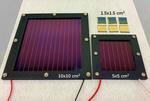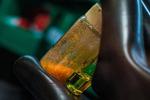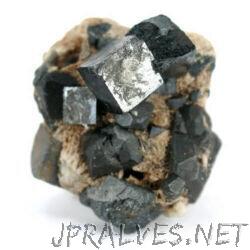Other

“Imagine living or working in a building where nearly every exterior surface can generate renewable energy. Panasonic is pursuing this vision by developing next-generation solar panels based on perovskite, a material that makes solar power generation more practical in environments …
News Toshiba’s Polymer Film-Based Perovskite Large-Area Photovoltaic Module Reaches Record Power Conversion Efficiency of 15.1%

“Toshiba Corporation (TOKYO: 6502), the world-leader in development of perovskite photovoltaic modules for next-generation solar power generation, has developed a new coating method for the perovskite layer that boosts power conversion efficiency (PCE) to 15.1% for Toshiba’s 703cm2 …

“Metal-halide perovskites are a new class of semiconductor materials for LED display and solar-energy harvesting. However, the best-performing devices are often made from lead (Pb)-based perovskites, whose toxicity may cause potential environmental concerns. To resolve the toxicity problem, an …

“Tin halide perovskites are currently considered the best alternative to their lead-containing counterparts, which are, however, still significantly less efficient and stable. Now, a team led by Prof. Antonio Abate from HZB has analysed the chemical processes in the perovskite …

“For today’s International Chess Day, a research team from ITMO’s School of Physics and Engineering presents a unique device – a chess set with light-emitting pieces that contain perovskite. The energy is delivered wirelessly into each piece using a …

“Although a very promising solution for capturing solar energy, perovskite solar cells contain lead, which is toxic to the environment and a serious health hazard. EPFL scientists have now found a very elegant and efficient solution by adding a transparent …

“A commonly studied perovskite can superfluoresce at temperatures that are practical to achieve and at timescales long enough to make it potentially useful in quantum computing applications. The finding from North Carolina State University researchers also indicates that superfluorescence may …
News Cutting Perovskite: Scientists Succeed in Shaping Microscopic Monocrystals Without Loss of Quality

“A research team that includes staff members of ITMO University has suggested a new method of processing miniature perovskite fragments. The method is cheap and makes it possible to fashion microcrystals into desired shapes for use in production of lenses …

“Solar cells, which convert sunlight to electricity, have long been part of the global vision for renewable energy. Although individual cells are very small, when upscaled to modules, they can be used to charge batteries and power lights. If laid …

“Engineers create seeds for growing near-perfect 2D perovskite crystals Rice University engineers have created microscopic seeds for growing remarkably uniform 2D perovskite crystals that are both stable and highly efficient at harvesting electricity from sunlight. Halide perovskites are organic materials …

